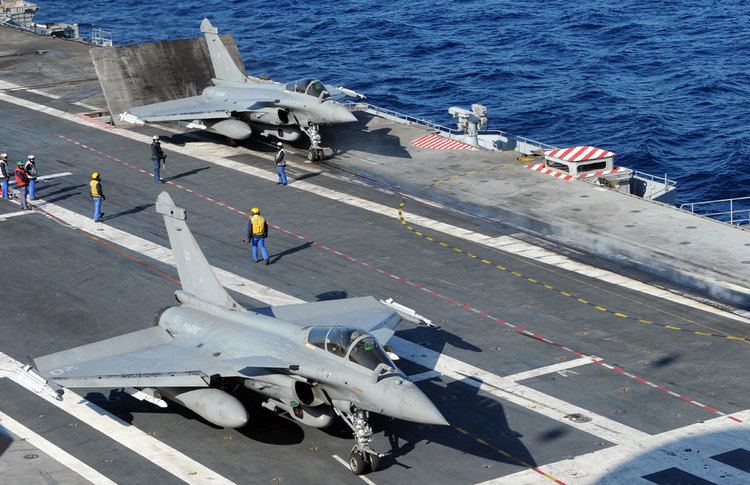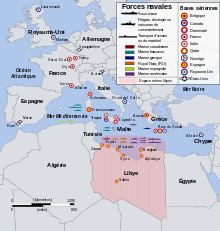Dates 19 Mar 2011 – 31 Mar 2011 | Location Libya | |
 | ||
See deployed forces See Libyan Armed Forces None Multiple tanks, aircraft, artillery units and ground targets destroyed Similar Operation Unified Protector, Operation Ellamy, First Battle of Brega, Battle of Bani Walid, First Gulf of Sidra offensive | ||
Opération Harmattan is the codename for the French participation in the 2011 military intervention in Libya. It is named for the Harmattan, which are hot dry winds that blow over the Sahara, mostly between November and March. The United States' counterpart to this is Operation Odyssey Dawn, the Canadian counterpart is Operation Mobile and the British counterpart is Operation Ellamy. The no-fly zone was proposed during the Libyan Civil War to prevent government forces loyal to Muammar Gaddafi from carrying out air attacks on anti-Gaddafi forces. Several countries prepared to take immediate military action at a conference in Paris on 19 March 2011.
Contents
- Deployed forces
- Day 1 19 March
- Day 2 20 March
- Day 3 21 March
- Day 4 22 March
- Day 5 23 March
- Day 6 24 March
- Day 7 25 March
- Day 8 26 March
- Day 9 27 March
- Day 10 28 March
- Day 11 29 March
- Day 12 30 March
- Day 13 31 March
- References

French Dassault Rafale planes began reconnaissance missions on 19 March and were the first among the coalition to attack Libyan forces, destroying four tanks.

Deployed forces

Day 1: 19 March
The French Navy anti-air destroyer Forbin and anti-air frigate Jean Bart were already off Libya when the operation commenced.
The French Air Force deployed in its first strike force eight Rafale fighters, two Mirage 2000-5 fighters and two Mirage 2000D fighter-bombers supported by other aircraft listed above.
Eight Rafale fighters patrolled the skies over Benghazi to prohibit the advance of Libyan ground forces. One opened fire on Libyan military vehicles at 16:45 local time. The Telegraph reported four Libyan tanks destroyed by French aircraft southwest of Benghazi.
Aircraft returning from combat missions landed at Solenzara Air Base on Corsica from which further combat sorties were launched.
Day 2: 20 March
Eleven sorties were carried out by French aircraft over Libya.
Task Force 473, the aircraft carrier Charles de Gaulle and its battle group, sailed from Toulon.
Day 3: 21 March
Up to this day, 55 sorties were carried out by French aircraft over Libya. The French Ministry of Defence (MoD) claimed a Mirage 2000-D destroyed another Libyan tank 100 km south of Benghazi.
Day 4: 22 March
Aircraft from Charles de Gaulle began operations over Libya, commencing with Rafale F3s conducting reconnaissance and patrols. Forbin and Jean Bart, which were already on station off Libya, joined Task Force 473. The number of combat aircraft forward deployed at Air Base 126 Solenzara was increased to 20 with the arrival of two more Mirage 2000-5 and two more Mirage 2000D, with support aircraft operating out of Saint-Dizier and Avord.
Day 5: 23 March
Rafale and Mirage 2000D aircraft from Solenzara and Rafale and Super Etendard aircraft from the Charles de Gaulle conducted reconnaissance and support sorties over Libya.
Day 6: 24 March
Rafale and Mirage 2000D aircraft attacked a Libyan air base, 250 kilometres (160 mi) inland from the Mediterranean Sea, with SCALP GP missiles. Rafale, Mirage 2000D and Super Etendard aircraft flew four joint interdiction missions against Libyan ground forces. A Rafale destroyed a Libyan Soko G-2 Galeb light attack jet with an AASM air-to-surface missile as it landed at Misrata. A patrol of two Mirage 2000Ds, equipped with GBU-12 laser-guided bombs, attacked loyalist artillery near Ajdabiyah.
Day 7: 25 March
Qatari aircraft attached to Operation Odyssey Dawn and French aircraft conducted joint reconnaissance sorties in the regions of Misrata, Zintan, Sirte and Ajdabiyah. Four Mirage 2000Ds conducted interdiction missions against loyalist artillery near Ajdabiyah. Two French and two Qatari Mirage 2000-5s conducted air interdiction missions. Three French Mirage 2000-5s were moved from Solenzara to Souda Air Base on Crete.
Day 8: 26 March
French aircraft carried out several air strikes around Zintan and Misrata, destroying at least five Soko G-2 Galeb light attack jets and two Mi-35 helicopters on the ground. French and Qatari Mirage 2000-5s continued joint reconnaissance sorties from Souda Air Base.
Day 9: 27 March
Air Force and Navy Rafales attacked a command centre south of Tripoli. French and Qatari Mirage 2000-5s conducted joint patrols and air interdiction missions from Souda Air Base. The number of French Mirage 2000-5s based as Souda was increased to four.
Day 10: 28 March
Air operations were planned to focus on the region around Zintan and Misrata. Air force Rafales and Mirage 2000Ds and a joint patrol of Navy Rafales and Super Etendards bombed an ammunition dump at Gharyan, 100 kilometres (62 mi) south of Tripoli. Mirage F1CRs conducted reconnaissance missions for the first time in the operation.
Day 11: 29 March
Two patrols of Air Force Rafales and Mirage 2000Ds and a patrol of Navy Rafales and Super Etendards attacked anti-aircraft missile sites 100 kilometres (62 mi) south west of Tripoli. Two joint patrols of French and Qatari Mirage 2000-5s conducted air interdiction sorties. Mirage 2000Ds and Super Etendards bombed a military depot 30 kilometres (19 mi) south of Tripoli.
Day 12: 30 March
A joint strike force of Air Force Rafales and Mirage 2000Ds and Navy Rafales and Super Etendards attacked anti-aircraft missile sites 20 kilometres (12 mi) south of Sirte. A patrol of two French and four Qatari Mirage 2000-5s conducted air interdiction sorties.
Day 13: 31 March
At 0600 GMT, NATO took command of all operations in Libya. Subsequent operations were conducted as part of Operation Unified Protector.
